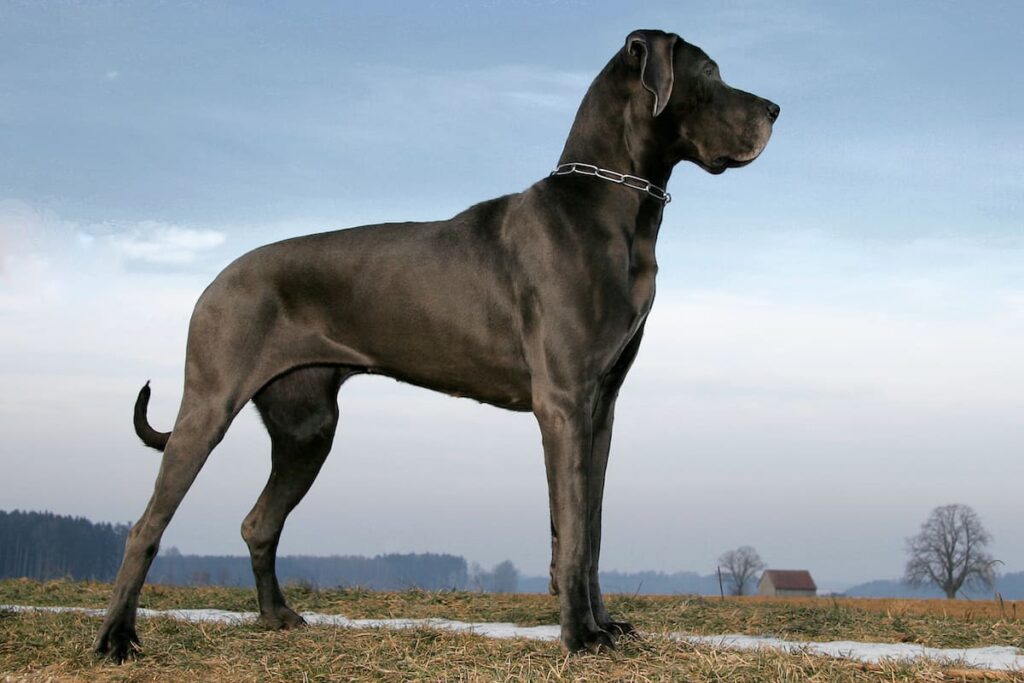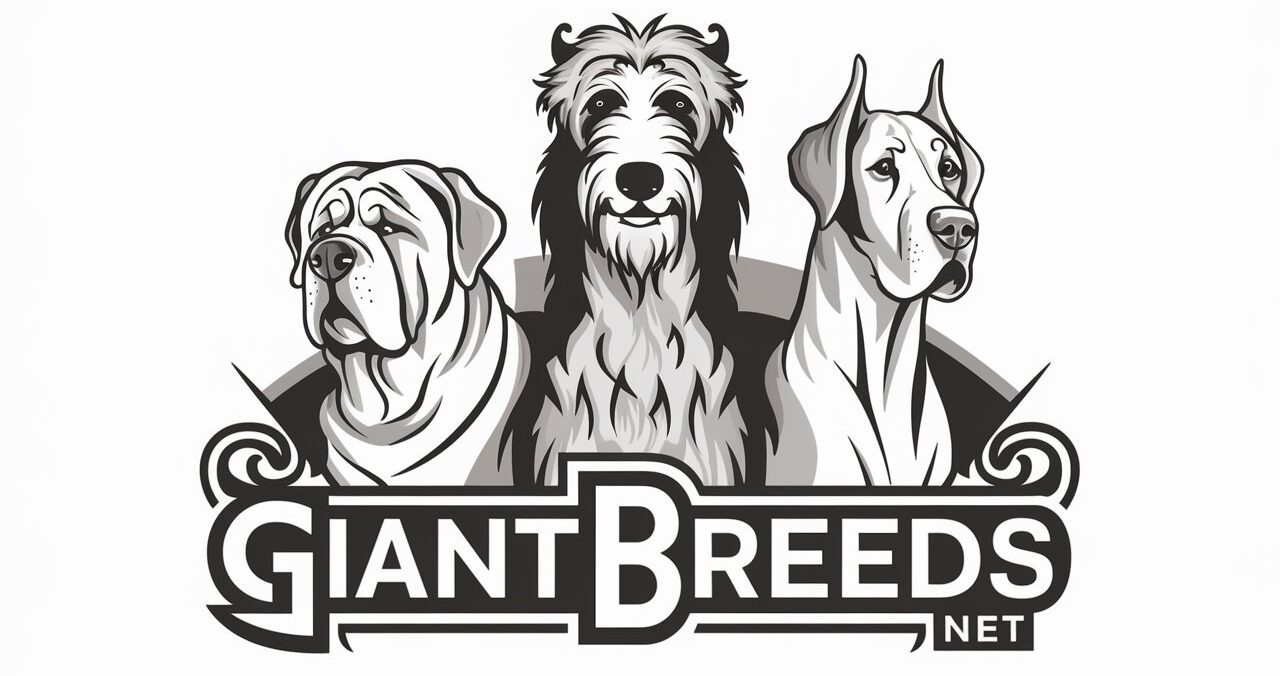
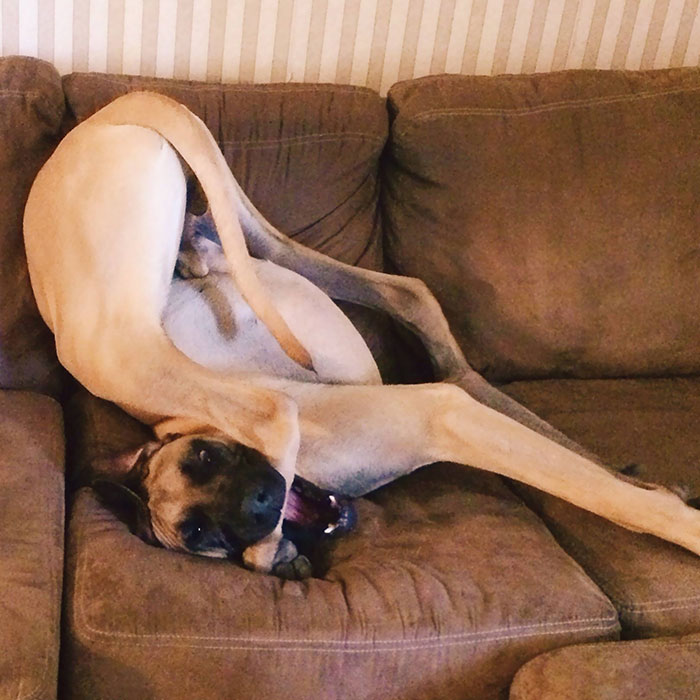
Characteristics of the Great Dane

The Great Dane: The Gentle Giant with a Heart as Big as Its Stature
When you think of dog breeds that make you stop in your tracks, the Great Dane is one that instantly comes to mind. These gentle giants are not only towering in size but also in affection. Let’s take a closer look at what makes the Great Dane such a lovable and unique companion.
A Size That’s Hard to Miss
Great Danes are true giants in the dog world, often standing between 28 to 32 inches tall at the shoulder. Weighing in at 100 to 230 pounds, they’re big, but don’t let that intimidate you. Their elegant build and regal posture give them an athletic look, but they’d much rather lounge on your couch than run a marathon.
A Temperament That Wins Hearts
Despite their size, Great Danes are some of the friendliest dogs you’ll ever meet. They’re affectionate, calm, and full of love. They greet you with a whole-body wag but are careful not to knock you over—a balance they manage with surprising grace.
Intelligence with a Dash of Independence
Great Danes are smart and quick to learn, but they’re also a bit independent. They might take a moment to think over your commands before deciding to oblige, making them a bit more thoughtful compared to other breeds.
Exercise: Less is More
If you think a dog this big needs endless exercise, think again. Great Danes are laid-back when it comes to physical activity. A couple of easy-going walks a day are enough for them. They’re more into lounging around than sprinting, content with a comfy spot at home as their throne.
Grooming: A Low-Maintenance Beauty
You might expect grooming a dog this size to be a hassle, but Great Danes keep it simple. Their short coat only needs a quick brush now and then to stay shiny and sleek. It’s as if they decided that their massive size should come with the perk of easy maintenance.
Great Danes are a delightful mix of size and gentleness, intelligence, and independence, all wrapped up in a low-maintenance package. They may be big, but their hearts are even bigger, filled with love, humor, and plenty of cuddles. Living with a Great Dane is a joy, full of laughs, love, and that famous big dog snuggles.

The Great Dane: A Tale of Two Giants
There are dogs, and then there are Danes. Great Danes tower above all, not just in size but in spirit. They are the Apollos of the canine world, elegant yet powerful, with hearts bigger than their massive frames. But ask any Great Dane enthusiast about the breed, and a debate as tall as the dogs themselves arises: European or American?
This is no modern dispute. It’s rooted in how these magnificent creatures have been bred and admired across continents. Some will tell you the European Dane is the true Dane—solid, substantial, and regal, with a head held high as though surveying an empire. Others will argue the American Dane is the epitome of grace—sleek and statuesque, with the movement of a polished dancer. Let’s dive into their differences, celebrate their similarities, and, by the end, remind ourselves that a Dane is a Dane.
What Makes a Great Dane Great
The Great Dane is not just a dog; it’s a work of art. Whether roaming the estates of Europe or lounging on an American couch, this breed has always been about presence. They command attention, not through noise but through sheer majesty.
Kennel clubs around the world agree on a few things. A Great Dane is:
- Tall: The males stand at least 30 inches, and the females aren’t far behind at 28. But height is only part of the story. The dog must also be balanced, proportionate, and dignified.
- Muscular: This is a working dog at heart, originally bred to hunt wild boar. Strength is not optional; it’s required.
- Gentle: Underneath the towering frame is a soul so kind and loving that families across the globe call them “gentle giants.”
Whether European or American, these qualities bind all Danes together. Yet, as with any grand story, the details reveal the intrigue.
The European Great Dane: Solid as the Old World
The European Great Dane carries the weight of history. It is a dog born from the hunting grounds of the aristocracy, where power was everything, and appearances had to match.
Look at a European Dane, and you’ll see:
- A Body Built for Strength: Broad shoulders, a deep chest, and a neck as thick as a tree trunk. These dogs look as though they could move mountains—or at least the dining table they just bumped into.
- The Head of a Monarch: Their heads are wide and square, with lips that droop slightly, giving them a wise, almost melancholic expression. These are not just dogs; they are kings among dogs.
- Stoic Temperament: Europeans say their Danes are calm, deliberate, and dignified. They are less likely to prance and more likely to pose.
And yet, beneath their imposing exteriors lies a heart as soft as any Dane’s. These dogs are loyal beyond measure, content to lay by your feet—or on them—at the end of the day.
The American Great Dane: Grace in Every Step
Cross the Atlantic, and the story changes. The American Great Dane is no less majestic, but its beauty is of a different sort. If the European Dane is a fortress, the American Dane is a cathedral—tall, elegant, and designed to inspire awe.
The American Dane is:
- Taller and Leaner: Their legs are long, their bodies athletic. They seem built not for the battlefield but for the runway.
- Sharper in Profile: The American Dane’s head is narrower, with tighter lips and cleaner lines. There’s a refinement here, a sense of artistry in every detail.
- Playful in Spirit: Where the European Dane sits calmly, the American Dane bounds. They are known for their goofy antics, their joy, and their tendency to act like oversized puppies well into adulthood.
This is a Dane that moves like the wind and loves with the force of a hurricane. They are clowns in a giant’s body, bringing laughter to every home they grace.
Two Danes, One Spirit
At a glance, the differences between these two types seem stark. One is a muscle-bound knight, the other a long-legged poet. But spend any time with either, and you’ll realize their similarities run deep.
Both Danes share:
- A Love for People: Whether bred in Europe or America, Danes live to be with their families. They are velcro dogs, sticking close to their humans no matter where they go.
- Big Hearts, Bigger Appetites: These dogs are lovers and eaters, devouring food and affection in equal measure. They are great dogs with even greater demands for belly rubs.
- Prone to the Same Woes: Sadly, both types are susceptible to health issues like bloat, hip dysplasia, and heart problems. Their towering frames come with a price, and owners must be vigilant.
At the end of the day, a Dane is not defined by its geography. It is defined by its love, its loyalty, and its ability to make even the most stoic among us laugh out loud.
The Great Debate: A Dane Is a Dane
So, which is better? The answer, as always, depends on who you ask. Lovers of the European Dane will point to its solid frame and quiet dignity. Fans of the American Dane will sing the praises of its elegance and energy.
But the truth is this: they are both Great Danes. Whether your dog has the heft of a mastiff or the grace of a deer, it’s still a Dane. It will still lean against you, knocking you slightly off balance but filling your heart with love. It will still chase its tail, forgetting for a moment that its tail is longer than most dogs’ bodies. It will still sit in your lap—because in its mind, it’s no bigger than a Chihuahua.
Final Thoughts
In the end, arguing over the differences between European and American Great Danes is like debating the merits of the sunrise versus the sunset. Both are magnificent in their own way, and both make the world a little brighter.
So, the next time someone brings up this age-old debate, just smile and say: “A Dane is a Dane. And they’re all goofy as hell.”

Why Great Danes Make Great Pets
The Great Dane: A Gentle Giant’s Guide to Being the Ultimate Pet
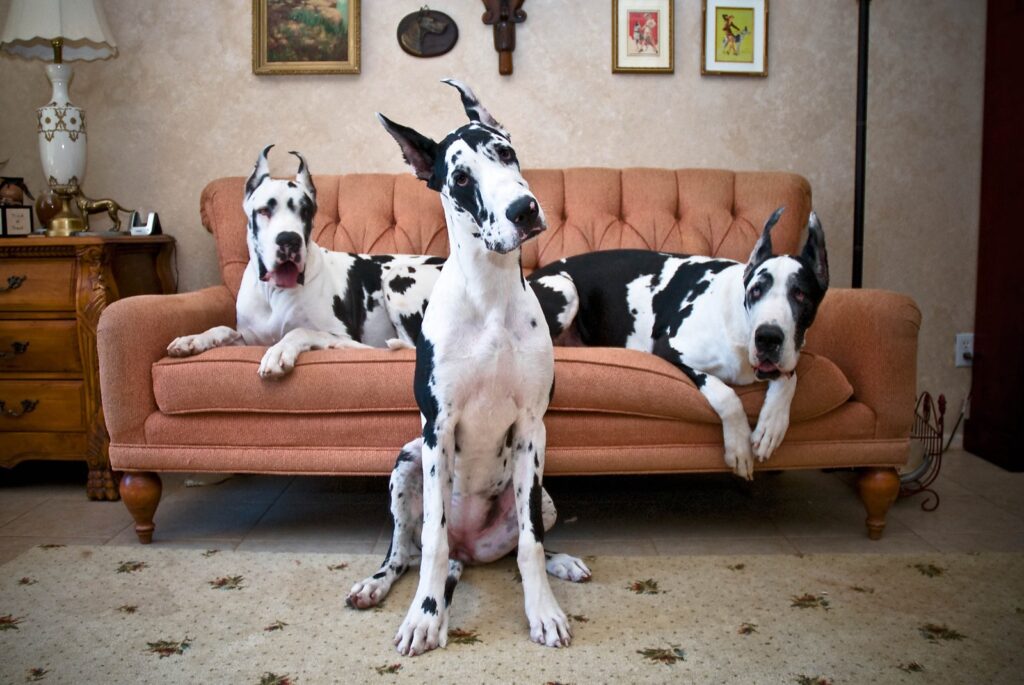
Welcome to the whimsical world of the Great Dane, the Apollo of dogs, where size is outmatched only by the heart! These majestic creatures are like the luxury SUVs of the canine world – roomy, comfortable, and surprisingly easy on the fuel. So, why do these colossal canines make such fantastic pets? Let’s dive into the life of living with a gentle giant.
Firstly, let’s address the elephant in the room – or should we say, the Dane in the living room? Their size is no joke; these dogs could easily double as small horses. Imagine coming home to a tail-wagging, face-licking creature that’s the size of a Fiat 500. It’s like having a living, breathing, slobbering piece of modern art that can look you in the eye while seated.
Here are the top ten injuries and incidents that Great Dane owners have reported, based on the most frequently mentioned to the least by owners:
- Back and Neck Injuries: Due to their large size and strength, Great Danes can accidentally cause back and neck injuries to their owners, especially when they jump or pull on the leash.
- Bruises and Scratches: Owners often report bruises and scratches from their Great Dane’s playful behavior, such as jumping up or roughhousing.
- Falls and Trips: Great Danes can unintentionally cause their owners to trip or fall, particularly when they get underfoot or pull suddenly on the leash. They can even trip over their own feet.
- Bites and Nips: While generally gentle, Great Danes can sometimes nip or bite, especially if they are startled or feel threatened.
- Joint and Muscle Strains: Handling a large and strong dog like a Great Dane can lead to joint and muscle strains, particularly in the arms and shoulders. Dislocated shoulder.
- Head Injuries: Owners have reported head injuries from their Great Dane’s enthusiastic headbutts or when the dog jumps up unexpectedly. Concussions to big knots.
- Dog Bites: In rare cases, Great Danes have been involved in more serious biting incidents, sometimes resulting in significant injuries.
- Foot Injuries: Stepping on or being stepped on by a Great Dane can cause foot injuries, given their size and weight. Broken toes.
- Knee Injuries: Sudden movements or pulling on the leash can lead to knee injuries for owners, especially if the dog is not well-trained on a leash. Dislocated knee.
- Facial Injuries: Enthusiastic greetings or play can sometimes result in facial injuries from a Great Dane’s paws or head. Scratches.
These incidents highlight the importance of proper training and handling to minimize the risk of injuries. Keep in mind they are not uncommon but they are not frequent. If you wonder if a Great Dane is right for you because of the above list ask someone who owns a Dane if it’s worth it. They will enthusiastically tell you of all the injuries they have. Something about a Dane owner just isn’t right.
Now, despite their grandeur, Great Danes are the epitome of the phrase ‘gentle giant.’ They’re the kind of dogs that will let kittens nap on their backs and toddlers use them as a moving jungle gym. They’re so affable that if they were people, they’d be the ones bringing you a casserole when you move into the neighborhood.
Intelligence? Check. These pooches are smart enough to know that their size can be… intimidating. So, they compensate with a demeanor so sweet, it could put sugar out of business. Training them is a breeze, as long as you’ve got treats and aren’t afraid to use them. They’re like big, furry geniuses who sometimes forget how big they are – like that one friend we all have who doesn’t know their own strength.
Liars? Yes, they will lie to your face. Great Danes, with their expressive faces and soulful eyes, can be quite the actors when it comes to denying any wrongdoing. If you catch them stealing food or getting into something they shouldn’t, they might give you an innocent look as if to say, “Who, me?” Despite their size, they can be surprisingly sneaky and will often try to charm their way out of trouble. However, consistent training and setting clear boundaries can help curb these mischievous behaviors.
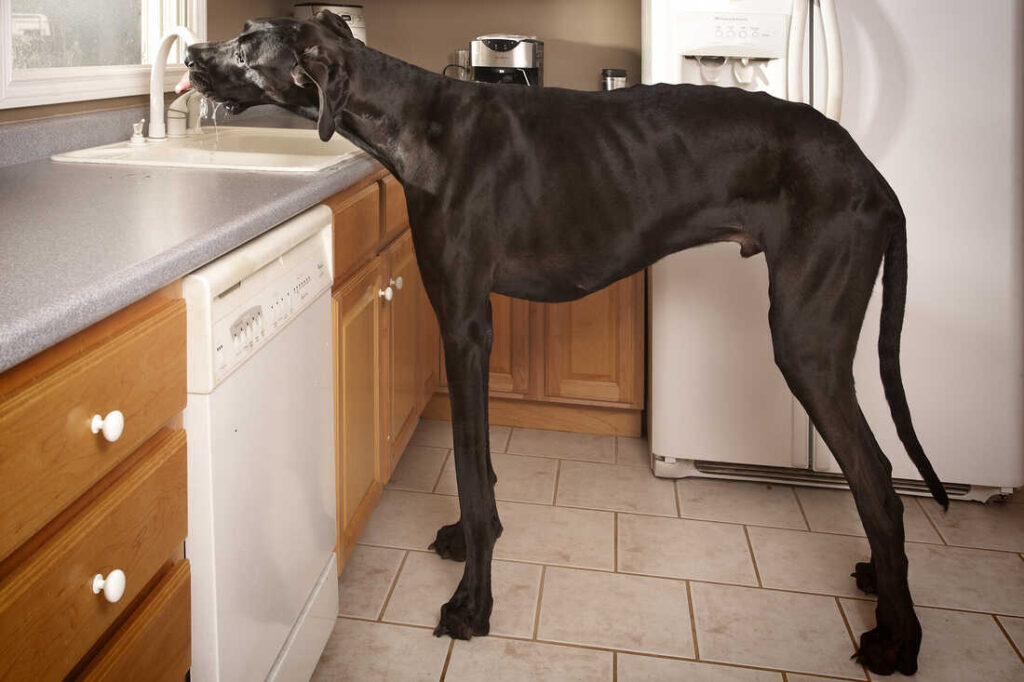
Exercise needs? Moderate. They’re like the friend who joins you for a leisurely stroll but isn’t signing up for a marathon anytime soon. A couple of short walks and they’re good to go, ready to resume their favorite pastime – impersonating a rug. A 30 to 60 minute walk will bring you a world of peace for the rest of the day.
And grooming? Let’s just say, if Great Danes were clothing, they’d be the ones with the ‘wash and wear’ tag. Their short coat is the envy of all long-haired breeds who spend hours being brushed, blow-dried, and styled. A quick once-over with a brush, and voila, they’re red carpet ready!
Shedding? Great Danes are considered moderate to heavy shedders. Despite their short, single coat, their large size means they can still shed a noticeable amount of hair. Shedding tends to be more pronounced during seasonal changes in spring and fall. Regular brushing can help manage the shedding and keep their coat healthy.
Why do they make such great pets, you ask? Well, they’re The Big Lebowski, they are the Dude of dogs, a Wal-Mart Greater – practically perfect in every way. They’re so loving and loyal that they’ll become your shadow (you will never pee alone again), your four-legged confidante who never spills your secrets. They’ve got a temperament so stable; they could balance your checkbook.
But what about keeping them engaged? Great Danes are like the intellectuals of the dog park. They enjoy a good puzzle toy, a hearty game of ‘find the treat,’ or simply a good ol’ fashioned debate about the mailman’s true intentions.
Ah, the mailman. To a Great Dane, the mailman is a daily enigma wrapped in a mystery, delivered with a side of suspicion. 🐾
Every morning, like clockwork, this strange human approaches the house with a bag full of mysterious items. What could possibly be in that bag? Treats? Toys? No, it’s always those boring paper things that my humans seem to care about. But why does he come every day? Surely, he must have some ulterior motive. Perhaps he’s plotting to steal my favorite chew toy or, worse, my comfy spot on the couch!
From my vantage point at the window, I see him coming from a mile away. I bark to alert my humans, but they just tell me to calm down. Calm down? Do they not realize the gravity of the situation? This is a matter of home security! I must protect my domain from this persistent intruder.
And then, there’s the way he leaves. He never stays long enough for a proper confrontation. He just drops off his suspicious cargo and scurries away, probably to plot his next move. But I’m onto him. One day, I’ll catch him in the act, and then everyone will see that I was right all along. Until then, I’ll keep barking and patrolling, ever vigilant, ever watchful. After all, a Great Dane’s work is never done. 🐶📬
If you’re looking for a dog that’s a conversation starter, a gentle soul, and a couch companion all rolled into one, then the Great Dane is your match. Just remember, they grow up to be big, so invest in a sturdy couch, reinforce your fences, and get ready for the grandest (and tallest) cuddles of your life. And maybe, just maybe, consider a step ladder for those hard-to-reach places – like the top of your dog’s head. Happy petting!
Caring for Great Danes: Special Needs and Considerations
Great Danes, often called gentle giants, are known for their massive size and kind-hearted nature. Despite their large stature, they’re beloved for their friendly and affectionate personalities. However, owning a Great Dane comes with its own set of responsibilities to keep them healthy and happy. Let’s dive into what it takes to care for these majestic dogs.
Socialization
Socializing your Great Dane is essential, especially from a young age. They need to meet different people, animals, and experience new environments to develop a balanced personality. Early socialization helps prevent fear and aggression, making sure they grow up confident and sociable.
Training
Training a Great Dane takes patience and consistency. They’re smart learners, but they can also be a bit independent. Using positive reinforcement, like treats and praise, goes a long way in motivating them and building a strong bond with their owner.
Exercise
Even though Great Danes have moderate energy levels, regular exercise is a must to keep them at a healthy weight and avoid obesity-related problems. Daily walks and playtime are key, but be careful not to overdo it, especially when they’re puppies, as their bones are still developing.
Space
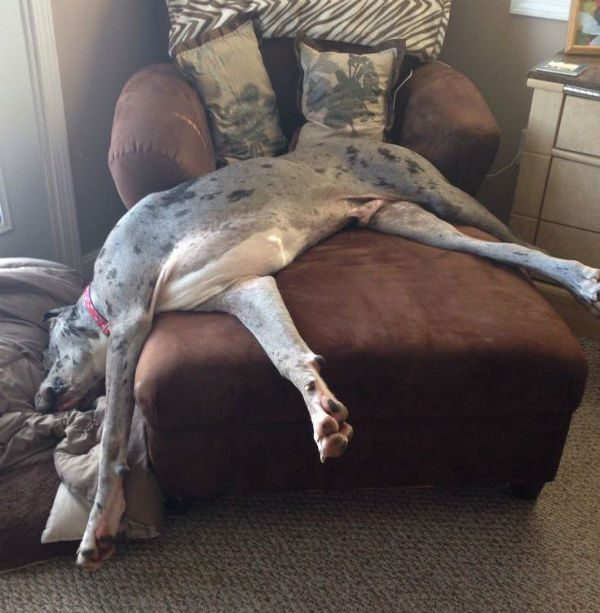
Great Danes need plenty of space to move around. Their size means they need room to stretch, play, and relax without feeling cramped. A spacious home with a secure yard is perfect for these big dogs to roam freely.
Health Care
Great Danes are prone to certain health issues like hip dysplasia and bloat. Regular vet check-ups are crucial to keep an eye on their health and catch any problems early. Knowing the signs of these conditions and acting quickly can make all the difference.
Nutrition
Feeding your Great Dane the right diet is vital for their health, especially during their rapid growth as puppies. A balanced diet tailored to their needs will support their development. Consulting your vet will help you choose the best food and portion sizes for your Dane.

Conclusion
Great Danes make amazing companions for those who can accommodate their size and love their gentle nature. They do best in homes where they get the attention, care, and space they need. If you’re thinking about bringing a Great Dane into your life, be prepared for a commitment. But with the right care, a Great Dane will reward you with loyalty, affection, and a presence that’s truly unforgettable. Ready for a lifelong friendship? A Great Dane could be your perfect match, bringing joy and companionship to your family.
🛠️ Skill Track Compatibility
Why These Tracks Are Listed:
done with their trusted human.
Great Dane is good at Companion Mastery because they thrive on deep bonds and are naturally people-oriented. Their gentle nature and desire to stay close make them ideal for structured relationship work.
Great Dane is good at Therapy because their calm demeanor and imposing but friendly presence often bring comfort. They’re natural gentle giants who respond well to people in distress.
Great Dane is good at Social Work because they are often non-reactive in chaotic environments. Their patience and size create both a soothing and steadying effect in public settings.
Drawbacks
The Gentle Giant: Considerations Before Bringing Home a Great Dane
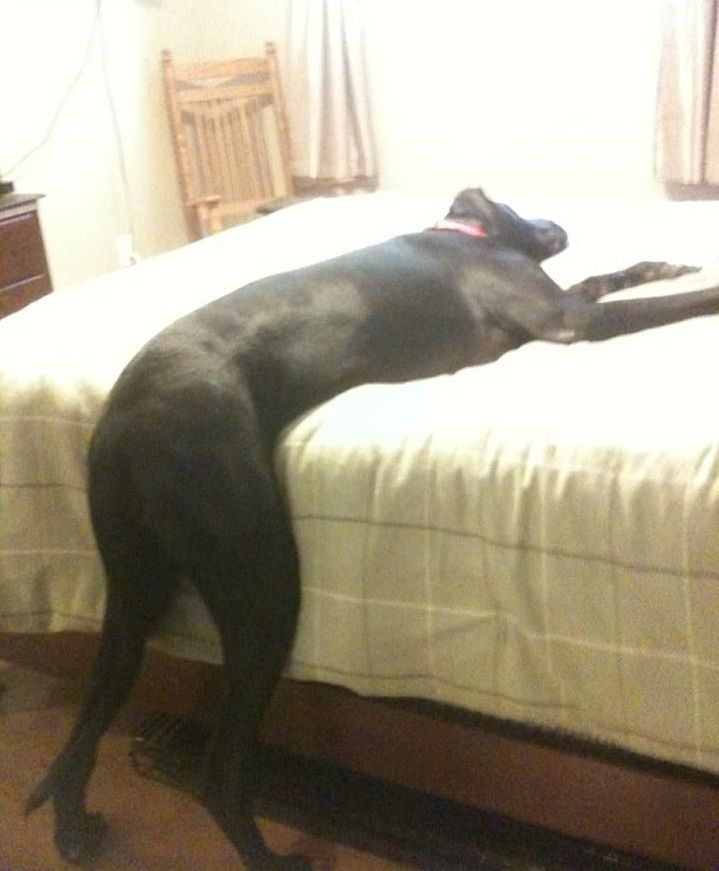
Great Danes, affectionately known as gentle giants, capture hearts with their noble looks and friendly demeanor. But like any breed, they come with their own set of considerations that potential owners should keep in mind. Let’s explore some key points before welcoming one of these majestic dogs into your life.
Size and Space Needs
First things first, Great Danes are big—really big. They often weigh over 100 pounds and stand tall at the shoulder, so they need plenty of room to move, play, and relax. A small apartment or a home without a spacious yard might not be the best fit. If you’re considering a Great Dane, make sure your living space can comfortably accommodate their size.
Health Considerations
Great Danes, like many large breeds, can be prone to specific health issues. Hip and elbow dysplasia, heart conditions, and the risk of bloat (a serious stomach condition) are common concerns. Regular vet visits and the financial ability to cover potential treatments or surgeries are essential for any Great Dane owner.
A Shorter Lifespan
One of the tougher realities of owning a Great Dane is their relatively short lifespan, usually between 6 to 8 years. The bond with these dogs is profound, and the thought of a shorter time together can be difficult. It’s important to cherish every moment with your gentle giant.
Growth and Development
Great Danes grow rapidly during their puppy years, which can lead to joint and skeletal issues if not carefully managed. It’s crucial to monitor their activity levels to prevent overexertion and ensure healthy development.
Exercise Needs
While Great Danes aren’t overly energetic, they do need regular exercise to stay healthy and avoid obesity. A consistent routine of walks and playtime is key to keeping them fit and happy.
Slobber Alert
If you’re someone who values a tidy home, beware: Great Danes are known for their slobber, especially after eating or drinking. This might be a deal-breaker for some, but with the right cleaning routine, it’s manageable.
Proper Nutrition
Feeding a Great Dane a balanced diet is vital for their growth and overall health. High-quality food tailored to their needs is essential, and consulting a vet for specialized nutrition advice can help ensure they’re getting the best care.
Heat Sensitivity
Great Danes are sensitive to heat, so if you live in a warmer climate, extra precautions are necessary. Keeping them cool and hydrated during hot weather is important to avoid any heat-related issues.
Socialization and Training
Early socialization is crucial for Great Danes to grow into well-adjusted adults. Exposing them to different environments, people, and other dogs helps shape their friendly nature. Training is also key, as these intelligent dogs can be a bit stubborn. Patience, consistency, and a firm yet loving approach will go a long way in fostering a well-behaved companion.
Size-Related Challenges
Their large size can be overwhelming, especially in households with small children or other pets. Proper training and supervision are essential to ensure they’re gentle around smaller beings and don’t accidentally cause harm.
The Gas Factor
Let’s not forget—Great Danes can be quite gassy! While it can be a humorous quirk, it’s something to be prepared for, especially in social settings. A good sense of humor and a few air fresheners can help you navigate this aspect of Great Dane ownership. Let’s face it their gas can clear a room.
Despite these considerations, Great Danes are incredible pets for those who are ready to embrace their unique needs. They require space, regular exercise, and an owner who understands their breed-specific characteristics. With the right preparation and commitment, a Great Dane can become a loyal and loving addition to your family. Don’t let these challenges deter you—instead, see them as part of the rewarding journey of owning such a majestic breed. With love, patience, and proper care, the joy of having a Great Dane by your side is immeasurable. Thorough research and preparation are the keys to a happy life with your gentle giant.

Ailments
Understanding the Health Concerns of Great Danes
Great Danes, known for their majestic appearance and gentle temperament, are a beloved breed among dog enthusiasts. Despite their overall robustness, Great Danes, like all breeds, have predispositions to certain health conditions. It’s crucial for current and prospective owners to be aware of these potential issues to ensure the well-being of these gentle giants.
Hip and Elbow Dysplasia
These conditions are common in larger breeds and stem from improperly developed joints, which can lead to arthritis and discomfort. Hip dysplasia affects the hip joint, while elbow dysplasia impacts the elbow joints. Both conditions can be managed with regular veterinary care, proper diet, and in some cases, surgery.
Gastric Dilatation-Volvulus (GDV) or Bloat
GDV is a critical condition that can occur in deep-chested breeds like the Great Dane. It involves the stomach twisting on itself, leading to a rapid onset of life-threatening symptoms. Preventative measures include feeding smaller, more frequent meals and avoiding vigorous exercise around feeding times.
Osteosarcoma (Bone Cancer)
Great Danes are at a higher risk for bone cancer, which can manifest as lameness, pain, or swelling. Early detection through regular vet visits is key to managing this condition, which may involve surgery, chemotherapy, or radiation.
Entropion
This eyelid disorder, where the eyelid rolls inward, can cause significant discomfort and damage to the eye if left untreated. Surgical correction is often required to prevent long-term issues.
Panosteitis (Growing Pains)
Commonly affecting young, growing dogs, panosteitis causes intermittent lameness and pain but usually resolves as the dog matures. Pain management and monitoring are essential during this period.
Luxating Patella
The kneecap slipping out of place can cause pain and lameness in affected dogs. Treatment ranges from conservative management to surgical intervention, depending on the severity.
Patent Ductus Arteriosus (PDA)
This congenital heart defect is characterized by an abnormal blood vessel that remains open after birth, leading to improper blood flow. PDA can be corrected surgically to prevent complications.
Preventive Care and Management
For Great Dane owners, understanding these health concerns is the first step in preventive care. Regular veterinary check-ups, a balanced diet, appropriate exercise, and being attentive to the dog’s behavior for signs of discomfort can make a significant difference in the quality of life for these dogs.
By being proactive and informed, owners can help their Great Danes lead full, healthy lives. Remember, early detection and treatment are often the keys to successfully managing these health issues. Always consult with a veterinarian for the best care strategies for your Great Dane.
Balanced Diet
Crafting a Balanced Diet for Your Great Dane
Great Danes are not only one of the largest dog breeds, but they also have a heart to match their size. These gentle giants require a diet that’s as grand as their stature to maintain their health and vitality. A well-balanced diet is crucial for supporting their rapid growth as puppies and maintaining their large size as adults. Here’s a comprehensive guide to feeding your Great Dane the right way.
High-Quality Protein Sources
Protein is the building block of a healthy diet for Great Danes, essential for muscle development and maintenance. Look for foods where real meat, such as chicken, beef, or fish, is listed as the first ingredient. High-quality protein sources help ensure your Dane gets the amino acids necessary for a healthy body.
Balanced Calcium and Phosphorus Ratio
Calcium and phosphorus are vital for bone health, especially in a rapidly growing Great Dane puppy. However, an excess of these minerals can lead to growth disorders and bone issues. It’s important to find a diet that has a balanced ratio of these minerals to support healthy bone development without overdoing it.
Moderate Fat Content for Energy
Fats are a dense source of energy and are important for maintaining your Great Dane’s coat and skin health. Look for diets that include sources of Omega- and Omega-6 fatty acids, which can help promote a shiny coat and healthy skin.
Complex Carbohydrates for Digestive Health
Carbohydrates provide an additional source of energy and are important for digestive health. Whole grains, vegetables, and fruits can offer the fiber needed to keep your Great Dane’s digestive system running smoothly. Avoid diets with excessive filler carbohydrates that offer little nutritional value.
Avoiding Bloat with Proper Feeding Practices
Bloat is a serious health risk for Great Danes. To help prevent this, feed your dog smaller, more frequent meals rather than one large meal. Also, ensure your Dane has a quiet time after eating; vigorous exercise before or after meals can increase the risk of bloat.
Supplements and Additives
Depending on your Great Dane’s specific needs, you might consider supplements. For example, additional glucosamine can be beneficial for joint health. Always consult with your veterinarian before adding any supplements to your dog’s diet.
Hydration is Key
Ensure your Great Dane has constant access to fresh water. Proper hydration is essential for all bodily functions and can help prevent urinary tract issues and aid in digestion.
Treats in Moderation
While treats are an excellent way to bond with your pet and provide training incentives, they should be given in moderation. Treats should not make up more than 10% of your Great Dane’s daily caloric intake to avoid obesity and nutritional imbalances.
Complex Carbohydrates for Digestive Health
Carbohydrates provide an additional source of energy and are important for digestive health. Whole grains, vegetables, and fruits can offer the fiber needed to keep your Great Dane’s digestive system running smoothly. Avoid diets with excessive filler carbohydrates that offer little nutritional value.
Avoiding Bloat with Proper Feeding Practices
Bloat is a serious health risk for Great Danes. To help prevent this, feed your dog smaller, more frequent meals rather than one large meal. Also, ensure your Dane has a quiet time after eating; vigorous exercise before or after meals can increase the risk of bloat.
Supplements and Additives
Depending on your Great Dane’s specific needs, you might consider supplements. For example, additional glucosamine can be beneficial for joint health. Always consult with your veterinarian before adding any supplements to your dog’s diet.
Consulting with a Veterinarian
Always consult with a veterinarian to tailor your Great Dane’s diet to their individual needs, especially if they have any health concerns. A professional can provide guidance on the appropriate portion sizes and any dietary adjustments needed as your dog ages. By following these dietary recommendations, you can help ensure your Great Dane stays healthy, happy, and ready to fill your life with love and slobbery kisses. Remember, a proper diet is the foundation of a long and healthy life for your furry companion.
